Why a smart antenna is the best solution for wireless networks with a high density of client devices

As the number of devices connected to the wireless network grows, the amount of content Wi-Fi users work with also increases, and the load on the network itself increases, due to which its performance and throughput may drop. It would seem that to fix this problem, it is enough to install additional access points ...
However, increasing the density of points creates new problems, because if the same channel is used for several connections, they will interfere with each other. Although multi-user MIMO (MU-MIMO) and beamforming technologies are often advertised as a solution for eliminating signal overlap, in practice, the effect of using them is negligible except for use in ideal conditions.

To overcome the natural limitations of the available channels and frequency bands, you need to find other ways to improve speed and ensure the stability of wireless connections.
People came up with the technology of smart antennas, which implements a fundamentally new approach. The smart antenna selects from hundreds of available signal patterns the one that is best suited to connect the client device to the antenna at the moment. The analysis of the external conditions and the choice of the optimal diagram are repeated at intervals of tenths of a second, and as a result, the users who move with their mobile devices always have a wireless network that works quickly and reliably. At the same time, the imposition of connections is minimized, since each connection uses its own signal directivity pattern, which ensures maximum performance.
')

Wireless coverage is also a difficult problem for many organizations that actively use Wi-Fi, and they often have to compromise between coverage and network capacity. To improve performance, you can add access points to the network, but then to prevent overlapping of signals, you will have to reduce the power of their transmitters and as a result, the network coverage will be less. The smart antenna allows you to solve this problem and using this technology you can increase the network capacity without reducing its coverage.
Smart antenna technology also works independently of client devices, so it can be used to connect with both the latest smartphone and an outdated laptop. At the same time, for the application of beamforming technology, it is necessary that the client device supports it, and at present only 20% of wireless devices are released with beamforming support.
So far, only some vendors use smart antenna technology in their products. Although the equipment with smart antennas is more expensive than standard, prices from manufacturer to manufacturer differ and you can find a completely acceptable option.
The use of smart antenna technology significantly improves the performance of users of a wireless network, especially when there is a high density of client devices, for example, in hotels, conference centers, exhibition complexes and universities. Any organization that actively uses Wi-Fi will benefit from the use of smart antennas primarily in places where there are usually many constantly moving users with multiple wireless devices. This innovative technology should pay special attention to those companies that are faced with the problem of high density of client devices in their wireless network.

Source: https://habr.com/ru/post/340438/
All Articles